“We’re talking a lot about restorative justice here, but those decisions were made decades ago and they certainly weren’t made by truckers or passenger vehicle owners.”
— Jana Jarvis, president of Oregon Trucking Assocations
At a meeting Tuesday night for the I-5 Rose Quarter project, people who seek restorative justice after their neighborhoods were decimated by the original construction of the freeway voiced frustration with the Oregon Department of Transportation for a lack of clarity around how exactly it would be meted out. At the same meeting, an influential trucking lobbyist appeared to marginalize the concept in a bid to absolve responsibility of truckers and car drivers from having to pay for it.
It all happened at a joint meeting of the project’s Executive Steering Committee (ESC), Community Opportunity Advisory Committee (COAC, which advocates for construction jobs) and Historic Albina Advisory Board (HAAB) hosted by ODOT. The agency called the groups together with the expectation that the HAAB would formally support the “Hybrid 3” option, a compromise design brokered by Oregon Governor Kate Brown that attempts to balance the state’s desire to keep the project timeline intact and show support for Albina neighborhood advocates’ vision for the rebirth of a thriving community over the freeway. ODOT’s initial plan included anemic covers that would only support open space, but HAAB members and other groups pushed for more robust covers that could support multi-level buildings (at least two stories, and possibly up to six).
But as we reported last week, while the Hybrid 3 option is acceptable to all stakeholders, it’s still just a concept and many thorny issues remain.
Given an opportunity to comment on the cover at the outset of Tuesday’s meeting, Oregon Trucking Associations President and chair of the City of Portland Bureau of Transportation Freight Advisory Committee Jana Jarvis said her constituents aren’t ready to fully support Hybrid 3. Their focus is to push for as wide of a freeway as possible. “It isn’t that we’re opposed to option three, particularly, but it’s premature to look for our support because there are a lot of unanswered questions,” Jarvis explained. Chief among them are: who will pay for the extra cost of larger covers (she feels truckers have already paid enough through increased taxes and shouldn’t have more financial burden from a larger cover), how the covers reduce the width of the freeway (“the whole reason we’re fixing that section of freeway hopefully, is to reduce congestion… Not to create opportunities for additional congestion”) and what exactly ODOT has planned for “restorative justice”.
Advertisement
Jarvis’ comments on that last point led to a mild rebuke from an advisor of Governor Brown’s Equity and Racial Justice Director Shannon Singleton. Here’s the exchange:
Jarvis:
“We’re talking a lot about restorative justice here, but those decisions were made decades ago and they certainly weren’t made by truckers or passenger vehicle owners.”
“I want to ask us to be careful about our comments. I can appreciate that there may be some disagreement on how and who’s responsible for restorative justice. But if you were sitting in this room and you benefit from white supremacy culture, I would ask that you be cautious about how you frame what restorative justice and undoing harm to the black community looks like.”
The idea of restorative justice has been made a top priority by every advisory group for the project. But what exactly it means in reality, and how this justice is executed on-the-ground is becoming a point of frustration and debate. Several HAAB members expressed concerns that there has been months of talk about restorative justice, but no action.
“We’ve had many, many, many conversations about restorative justice, and we use the terminology and are passionate about. But I have not heard one practical example of what it looks like,” said HAAB member and New Song Community Church Pastor Richard Probasco. “It’s a terminology that we’ve used incessantly, and it’s very frustrating… the thing we never get around to is, who’s going to pay for it? Where’s the money coming from? And so it’s a circle we go around and around, and quite frankly I’m dizzy.”
Advertisement
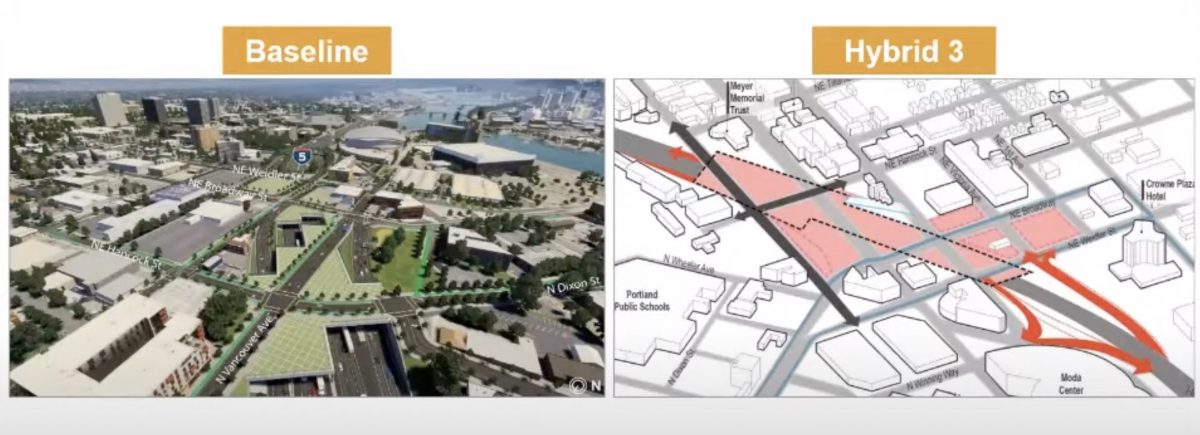
(Perhaps ODOT and other government agency leaders feel like restorative justice is a process-related promise fulfilled simply by listening to the community, while advisory committee members see it as something more tangible and equate it directly with jobs and programs and funding?)
Meanwhile, ODOT is getting impatient. The Hybrid 3 option is already a compromise for the agency. And while they’ve said it’s feasible and won’t throw off their plan to break ground in 2023, it was clear at the meeting they are feeling a sense of urgency to move forward. Because the ESC has committed to following the lead of the HAAB, ODOT hoped the HAAB would make a formal recommendation of Hybrid 3 Tuesday night. That’s because once the HAAB makes their recommendation, the ESC would then follow suit, then the design could move forward after adoption by the Oregon Transportation Commission (OTC) who are set to meet the first week in September. That’s a crunched timeframe.
“If we don’t have transparency about the conversations that are happening, there’s no way that this will be restorative.”
— Estelle Love Lavespere, HAAB member
Unfortunately for ODOT, only four of the 12 HAAB members were present Tuesday night. Without a quorum, members didn’t feel comfortable making any formal decisions. ODOT staff tried to suggest ways the recommendation could move forward regardless, but HAAB members stuck to their guns.
There was also HAAB member John Washington who mocked the process throughout the meeting by pointing out that Hybrid 3 is the only option on the table, so there really wasn’t a true choice being made. “Do we have other options? Y’all made it sound as if we had other options. And there weren’t any other options.” (In the end, Washington said he supports Hybrid 3.)
There were also rumblings of discontent with the process from HAAB member Estelle Love Lavespere, who voiced concern that the Hybrid 3 compromise was hashed out away from the HAAB. “That’s how hybrid three came about. [It] was the same people that sent us this letter [signed by Portland Bureau of Transportation Commissioner Jo Ann Hardesty, Multnomah County Commissioner Jessica Vega Pederson, and Metro President Lynn Peterson] saying, ‘Hey, we think this is how it should go’. And here we are. ‘Hey, pick Hybrid 3’. So now they’re saying, ‘Hey, this is how restorative justice should look like, you people wronged by this’….If we don’t have transparency about the conversations that are happening, there’s no way that this will be restorative.”

In addition to how restorative justice will be made real via the project, other upcoming debates are likely to center on what should be built on top of the covers, who will design them, and who pays for them. Jarvis with the trucking group has made it clear cost is a sticking point for their support.
ODOT Project Manager Megan Channell shared at the meeting that early cost estimates for the Hybrid 3 cover concept would increase the cost of the project by about 50% — from a top range of $795 million as currently designed, to as much as $1.25 billion with covers that can hold up to three stories. If it’s decided that the covers will have buildings up to six stories the cost could go up to $1.75 billion, Channell said.
One clear takeaway from last night is that while ODOT will get their desired support for Hybrid 3, there will be a long list of conditions attached.
“I just want to be clear, that just because there’s a letter supporting Hybrid 3, there’s also a letter supporting Hybrid 3 with a lot of ‘ands’, and that list could grow based on the HAAB’s recommendation,” Metro President Lynn Peterson shared at the end of the meeting.
In other news shared at the meeting, ODOT revealed that discussions and plans to move Harriet Tubman Middle School have already begun.
— Jonathan Maus: (503) 706-8804, @jonathan_maus on Twitter and jonathan@bikeportland.org
— Get our headlines delivered to your inbox.
— Support this independent community media outlet with a one-time contribution or monthly subscription.


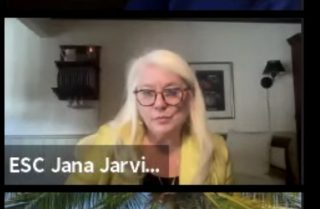
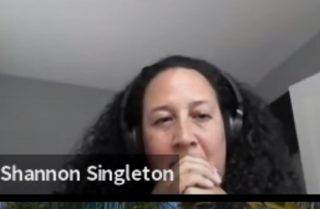
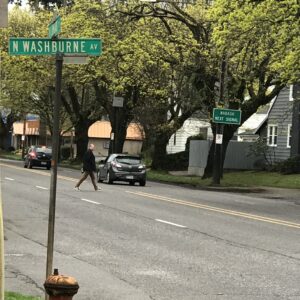
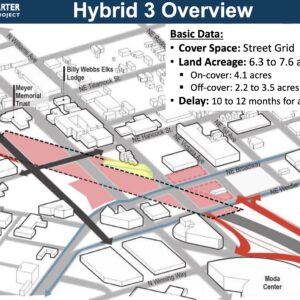
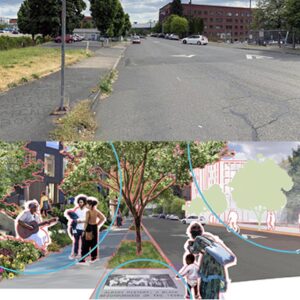

Thanks for reading.
BikePortland has served this community with independent community journalism since 2005. We rely on subscriptions from readers like you to survive. Your financial support is vital in keeping this valuable resource alive and well.
Please subscribe today to strengthen and expand our work.
If the HAAB were to endorse Hybrid 3, and then the trucking association rejects it, I gotta say…that would be pretty delicious. Watching ODOT get screwed over by the freeway-widening booster club — my ideal outcome here is endless delays and nothing ever happening* so I’d just grab some and watch.
* I do think the residents of Albina deserve to have their neighborhood reconnected — and ODOT and Portland owe them that — but as a separate project, not as a (literal) cover for freeway widening.
“I’d just grab some and watch” was supposed to be “I’d just grab some [popcorn emoji] and watch” — the emoji showed up in the comment box, but not in the published version.
I was enjoying wondering what it was you were going to grab, now you blew it for me! I figured beer.
What about other residents getting to have their neighborhood reconnected as well? It’s more than just Albina where discrimination took place.
Whataboutism. https://www.bing.com/search?q=whataboutism&cvid=f2f5c1c2a87644ae805b7146e3d63402&aqs=edge.0.0l7.3931j0j1&pglt=43&FORM=ANNAB1&PC=U531
Perhaps it is, but it is a legitimate question to ask why is this (predominately white) neighborhood is more deserving that other (predominately white) neighborhoods that were equally impacted.
Why do media report ODOT’s financial projections with a straight face?
ODOT has a record of continually underprojecting megaproject costs. And Bent Flvbjerg shows megaprojects around the world are continually underprojected – for political reasons.
Media should report these numbers with a big asterisk, and a note showing they’re likely 20-100% underprojected.
Wider lanes benefit freight. Wider radius curves benefit freight higher speed limits and fewer traffic controls benefit freight. Things that make roads more dangerous for vulnerable road users benefit freight. It is not surprising that freight, the beneficiary of taxpayer’s largess and infrastructure design standards would deny culpability for the wrongs wrought by transportation. Freight privilege is analogous to white male privilege.
Didn’t the freight lobby get the Oregon legislature to loosen weight restrictions on bridges just prior to the “cracked bridge” emergency in the 90s, that cost taxpayers hundreds of millions of dollars? I don’t see that pennies of savings per each truck’s cargo is fair compensation for freight’s impact.
This is satire, right?
I’m afraid that he might be serious. One man’s freight is the next day’s groceries in the refrigerator. We are all part of the ‘problem’
Ms. Jarvis’s attempts to absolve her clients (truckers) and other drivers from restorative justice responsibility shows a lack of both historical knowledge and sensitivity. Who benefited from I-5 carving the heart out of Albina? Her clients, and everyone who commutes on I-5. If we’re going to take restorative justice seriously, they need to be part of paying for it. In a very real sense, the Albina community has subsidized the trucking industry for decades. Now that the bill is coming due, with interest, they’re trying to claim they didn’t sign the loan.
The recently published census data shows that Albina and the surrounding census tracks showed a massive movement of Black people out of those neighborhoods and a commensurate influx of white people. From 2010 to 2020 one of the census areas showed a 49% decrease in the percentage of the population that is Black.
I agree that I-5 was a giant hit to the Albina neighborhood. I also agree that truckers and folks outside the neighborhood benefited from this. It seems that there is also a massive devastating hit that has occurred by relatively affluent white people taking advantage of the lower property values in a historically Black part of town.
I’m really curious to see if any of the white folks who moved into NE in the last 10-20 years will take any responsibility for the gentrification and displacement that they caused directly.
The reason I ask, is that I’m really curious to see if there are any white people in Portland who are willing to say, ‘yeah, I caused this displacement and pain and I’m willing to take responsibility for it’. I think what Jarvis said was flawed, but I’d like to see if anyone is willing to own their role or if it’s just easy for a bunch of Portland white liberals to blame the truckers for their own shit.
Where are you seeing the 2010-2020 tract level comparisons? The Washington Post had a good interactive map, but it was changes between 1990 and 2020.
How is it someone’s fault for buying a house that was for sale? Any house buying transaction I’ve taken part in I never was told why the house was being sold so why should I be taking responsibility for something I was not aware of at the time?
I highly doubt the top thing in a house buyers mind is “how am I going to shaft the people selling this house and make them suffer?”
Maybe instead of focusing on gentrification (the result) people should look at the cause, barriers in employment, education, and yes housing for people of color. Solve for that and I bet there won’t be much more gentrification.
So you’re pretty much exactly like the truckers. ‘how is this my fault, I only benefitted’. Which is my point.
Like the truckers you’re likely to want other people to pay for the caps. Not that this makes you bad. It’s just that lots of us do what the truckers are doing here.
It’s easy for us to call out the truckers. It’s hard for us to look at ourselves. This article just seems to dunk on the truckers for shit lots of other people are doing. That seems unfair to me.
I share SolarEclipse’s question: “How is it someone’s fault for buying a house that was for sale?”
Your rebuke doesn’t pretend to answer.
Another question is “How is it someones fault for using a freeway that was built?”
I’m a gentrifier in historic Albina. I moved into this neighborhood because my two children are Black, and it was important to me that they grow up in a neighborhood where they’d see other kids like them. I didn’t buy my house from a Black family, but a white woman who was a real estate agent renting her house to a group of, as far as I know, young white folks. I am white and certainly benefit from that as well as economic privilege. Any white person who grew up in a suburb benefited from the interstate highway system, which enabled white flight out of cities.
Not everything in the neighborhood has gentrified, however. Harriet Tubman serves a majority kids of color population, as does the local elementary, Boise-Eliot/Humboldt. There are many Black churches that are still packed on Sundays (in non-pandemic times). Certainly Dawson Park is a place where many Black residents still spend time.
But what you’re also missing in your comment is that Albina Vision Trust, the Black-led group pushing for caps, is working to restore the grid and build housing to help some of the people displaced from Albina return here.
And what you’re also missing is that a some of us white folks in the neighborhood are listening to what our Black neighbors are asking for.
The reason why should be evident. Do you want to live next to a freeway?
Gentrification starts at city hall when they allow construction permits for properties that gentrify. Gentrification is not driven by the people that move into gentrified neighborhoods, it’s driven by wealthy land developers.
This is not something that can fall on individuals to claim responsibility. Which is why tax dollars should be used to balance the ledger. Collectively, as a community and as a state, this was perpetrated and shall be corrected.
This statement is incendiary, not insightful.
Jason,
Sorry you found it incendiary. What I’m asking is if there are any white folks who are willing to take ownership over their role in gentrification/ripping the heart out of Albina (as Michael Mann suggested had happened with I-5) and the subsequent gentrification that has accelerated this century.
What I see here are people: 1) blaming the truckers association and people who live in Vancouver (Michael) 2) blaming “wealthy developers” (you) and 3) elaborate posts about how bike lanes aren’t the problem.
All of these responses are tactics that shift blame to other ‘out groups’ or rationalize how ‘we’ can’t possibly be the problem.
I suggest that maybe scapegoating others rather than taking ownership is a problematic response. You really think there is no culpability for the massive influx of generally affluent white people coming into NE Portland to exploit relatively low housing prices bare zero responsibility?
And you really actually think that the shift of Black people moving from inner NE to lower cost areas is to avoid freeway emissions? Does that also explain the drastic increase in housing prices?
Then there is Joan. Who does take responsibility though her experience is seemingly rare and not the affluent opportunists I’m talking about.
I blame myself and I blame the trucking lobby and a I blame a lot of other things. It’s possible to blame many things simultaneously.
Thank you. I think this is the correct and fair position. I sadly don’t think your position is widely held.
It just galls me to see what seems like pointing fingers without taking ownership. Jason, as just one example, blames faceless ‘wealthy developers’ and considers it incendiary to suggest others may also be to blame.
Must I atone for moving to Portland last decade? And/or for the 1966 cleavage of the Albina neighborhood?
Yeah, good question. So there’s a thesis put forward in the book “how to be antiracist” that the outcomes matter, not what is intended. If a policy increase s racial disparity, it’s a racist policy.
It’s a fascinating theory and intriguing to apply to a variety of situations. Gentrification we can say increases racial disparity and fractures the Black community. The actions that drive gentrification include relatively affluent white people buying homes in places that are cheaper because they were historically Black.
Buying a house in this way adds to gentrification, this increases racial disparity. QED, according to the theory, it is a racist action. Racism I’ll assert is bad and thus needs atoning.
Now, you could say this is silly, that you’re just doing what people do. That’s a fine position to take, but then you have to ask, what did the truckers do that was worse than what you did in buying that cheap house in the Black part of town? Maybe neither of you are culpable. That would be consistent. But if the Truckers are culpable, then so are you.
I just don’t want to see people hold up moral litmus tests that they themselves can’t pass.
Apparently a lot of people do. The gentrification of the neighborhood and the dramatic rise in property values does to some degree challenge the assertion that the neighborhood was destroyed by the highway. To a degree it might have been, but there are clearly plenty of people who still want to live there, and there are very few people still there who lived there when the highway was built.
You say we need to “balance the ledger”. How do you mean this, exactly? By any statistical measure, the neighborhood is thriving. Yes, there was a lot of disruption many decades ago, but, common to the nature of cities, there has been disruption and displacement since well before the area became a predominantly African American neighborhood, and the construction of I-5 and I-205 caused significant disruption in other neighborhoods as well.
I’m not opposed to reducing the impact of the highway, but the notion that the general public (or the trucking industry) “owes” it to the current residents (most of whom chose to live there after the highway was constructed) is difficult accept. And aren’t residents of other impacted neighborhoods owed an equal debt?
This is an odd way to define gentrification, which can occur by not building enough, as is the case in much of San Francisco. If you have a limited housing stock, restrictive zoning requirements limiting new construction, and excess demand, you’ll get gentrification — even without any new buildings popping up.
This form of gentrification is not caused by a swanky new condo, but by single family zoning & restrictive land use policies, leading to the underdevelopment of high-demand areas near our city core. Wealthier people are pushed to look in lower-income areas for housing they can afford, changing the socioeconomic makeup & character of the places to which they move.
The Willamette Week wrote about this 15 years ago, in the exact neighborhood we’re talking about.
I would posit that no city has kept housing prices down by building swanky new condos. The situation is much more complex than the simple supply/demand picture you paint, and there are well known mechanisms by which swanky new condos increase housing prices even as they nominally increase supply. (Yes, of course you can claim the swanky new condos have kept prices lower than they would otherwise be, but that is an unprovable counterfactual.)
Jarvis is engaging in double-speak. The truth is the opposite of what she said.
The lobbyist spoke the truth and nobody likes it. The government is looking for a new bogeyman and refuses to take responsibility for what it did decades ago. Don’t like the freight industry? Cool, grow your own toilet paper.
It’s always absolutes with some people, I guess.
The trucking industry in Oregon gets away with operating old equipment that pollutes significantly more than fleets in surrounding states. They also pay tax rates that are relatively low when compared with other countries. It is possible to participate in a society and still push for improvements. Yes, it will cost more to transport goods if we improve our roads for active users (more traffic delays), mandate cleaner fleets (increased capital costs), and raise fuel taxes to fund maintenance work to repair the damage that these vehicles cause. As trucking becomes more expensive, other cleaner alternatives will become more competitive.
So what states mandate that the freight industry use in surrounding states? Also, who sets the truck tax rates? Oh the legislature? So your beef is with them. And yes, enjoy the products you get on the shelf. It gets there one way and one way only.
So, growing my own toilet paper is the only option? I shouldn’t engage in the political process? What kind of reductionist nonsense is this?
This whole thing is a made-for-Portland never-to-be-resolved sh*t show. I don’t pretend to know the answer but I’m pretty sure half a decade of new highway construction in lower Albina isn’t the answer!
What is the plan for restorative justice for those affected by the building of I-84? Why is all the focus on I-5?
I-84 was built in a ravine (Sullivan’s Gulch) that housed few if any people. There was a golf course there before the freeway was originally built.
Sigma,
That is only true for inner Portland. Further east was decimated by I-84. Construction of I-84 created a huge negative impact for even close in Portland. Just look at this photo before the interstate and try to say I-84 didn’t disconnect communities.
You’re going to have to elaborate. What am I supposed to take from this?
It was less impactful, but there are many houses that were and continue to be negatively impacted on the I-84 corridor. We can’t really use our front yard, because of the noise from I-84. I had to spend thousands upgrading the 100 year-old windows and doors to finally block out the noise, and we can still hear it when a jake-braking truck or crotch rocket goes by. The diesel particulates from the dirty Oregon-standard diesel trucks is noticeable all over our neighborhood. Next time you drive I-84, look for the sound walls. In most cases, there are houses just behind these walls.
So, government policies that deliberately targeted and destroyed the only viable black neighborhood in Oregon is equivalent to someone needing double paned windows on their million dollar bungalow?
For someone living in outer NE PDX just on the other side of the I-84 sound wall, I doubt their house is a ‘million dollar bungalow’. And FWIW, the N Mississippi district is only a couple of blocks away from I-5 and has done fine *since it was gentrified*; before that it was mostly boarded up businesses and crack dealers on every street corner; who should we blame for that, ODOT, the bankers or someone else?
Sigma,
That seems to be an uniformed comment. Many people were negatively impacted by the interstate build out in Portland besides just those in Albina. POC too. The interstate wasn’t placed in wealthy neighborhoods. Ride your bike along I-84 tomorrow. There are many modest homes right up to the edge of the freeway. These neighborhoods were negatively impacted as well. They deserve justice as well.
My street doesn’t have any houses worth more than $500k on it, mainly because of our proximity to I84. I’d love to have the home values of Albina.
I love the way you framed the issue: How exactly will restorative justice be meted out?
Just want to point out that Jana Jarvis is also chair of the Portland Freight Committee. It’s disappointing to see someone in that position making comments so antithetical to City of Portland policies and values.
Might I assume your remarks are sarcasm? The point of serving on any government commission, board, authority, or committee is to advise and if necessary persuade government agencies on courses of action for the greater progressive good of our common society, sometimes in a direction that is contrary and even “antithetical to City of Portland policies and values.” Is it possible those self-same policies and values are wrong? For decades after annexation PBOT refused to build sidewalks in East Portland, the poorest part of the city, because to do so would violate city policies and values. I was part of a team that got the city to reverse its policies and values. I don’t necessarily endorse Jana Jarvis’ point of view, but I do certainly respect and admire her efforts to risk her position on the PFC to ask difficult questions not only of the city government but also of the community at large.
Do you currently serve on a board, commission, or a committee? If you do, congratulations, for as you already know, there is far more to democracy than voting, watching the news and serving on juries. If you don’t, why not? What is preventing you from serving on at least your local neighborhood association? Or asking to be appointed to the BAC?
She’s a lobbyist advocating for her constituency, and not for Portland ‘policies and values’.
Geez, if calling someone part of ‘white supremacy culture’ is a mild rebuke, I would hate to hear what a strong rebuke is. As long as the woke continue to use language like that, you can be 100% sure that I, and hundreds of millions of other world citizens, will oppose them at every turn.
“White supremacy culture” is now used to be essentially synonymous with “main-stream culture”*, you know, valuing things like being on time for a job or the ability to express yourself well through writing. As is it has been redefined, I’m really not even sure it’s much of a rebuke at all.
We probably need a new word to mean the the culture of actual white supremacists (the bad kind).
*If I’m wrong, please provide some examples of how the two differ.
I think the burden is on you to show any evidence to back your straw man.
Tema Okun coined the term “white supremacy culture,” and her website Dismantling Racism asserts the following “characteristics”: perfectionism, sense of urgency, defensiveness, quantity over quality, worship of the written word, only one right way, paternalism, either/or thinking, power hoarding, fear of open conflict, individualism, I’m the only one, progress is bigger/more, objectivity, and right to comfort.
As ridiculous as what Watts wrote sounds, Okun’s essay shows that it’s true.
Well, she got the “defensiveness” part right. I see a gaping maw between your description of Okun’s definition and your equivocation of that with “mainstream” culture. I think you’re fearful because *your* culture is in such steep decline.
Smearing me as a white supremacist for expressing disagreement with the origin document for the term “white supremacy culture” reinforces Watts’ point: “We probably need a new word to mean the the culture of actual white supremacists.”
Your message is poisonous and your logic is circular, but points for irony.
See, defensiveness is when no one calls you a white supremacist but you react as though they did anyway. A lot of white males your age get like this when challenged. So fragile!
This exchange is a little bit confusing.
1. Steve Scarich wonders aloud how being told that one is part of “white supremacy” culture could be considered a “mild” rebuke. Implication being that it sounds fairly harsh, not “mild”.
2. Watts attempts to explain that “white supremacist culture” might be used to just describe all “mainstream” culture, citing a few seemingly tongue-in-cheek examples, so it isn’t really all that harsh to be deemed a “part” of it. Asks for “correction” if “white supremacist culture” is actually significantly different from “mainstream culture”.
3. The Dude calls Watts’ description of “white supremacist” culture a “straw man” and claims burden is on Watts to show that WS culture == mainstream culture.
4. Mark in NoPo then cites an actual essay by Tema Okun that describes WS culture in terms that are very similar to Watts’ description, seemingly supporting the notion that Watts’ description–though perhaps ridiculous-sounding–was not so much a straw man after all.
Question 1: How is providing the “back[ing] for [a] straw man”–with citations, no less–being “defensive”?
Question 2: The only discrepancies I can find between Watts’ description of WS/mainstream culture and that in the essay are perhaps in completeness and inferred sincerity level. Assuming you read the referenced essay, where is the “gaping maw”?
Question 3: When you use the emphasized term “*your* culture”, what are you referring to, and how do you know to which culture anyone “belongs”?
I have other questions, but I will forego them for now to make a plea to all those who consider themselves superiorly “woke”: if you see something outrageous, please point out the specific aspect(s) that make it outrageous. Simply ridiculing someone that you consider to be uninformed will not further understanding. I realize that, as a fragile white person, individual acts of ridicule against those like me are not comparable to the experience of those living in a system that is biased against them (see, I read the essay!), but nevertheless, resorting to ridicule over rationality exhibits several attributes of WS culture, which I assume you disdain(?): perfectionism (the person you are ridiculing hasn’t “done the work” to achieve a full and correct understanding), power hoarding (The ridiculer claims moral superiority and reserves the right to “cancel” those that don’t “get it”), paternalism (the moral elitist with a clear view of right/wrong can dictate to others what ought to be done without explaining why), and either/or thinking (one either “gets it” or one doesn’t. there is no journey to understanding). Irony?
I know this is long, and you can call me “defensive” if you want to, but there are many people like me who have been living blind, having been told a version of things since childhood that we now are starting to see was off. We have legitimate questions regarding how far and in which direction(s) the story we were told was “off”. When the first explanation one receives goes along the lines of, “well, you see, you’re a racist who is part of a white supremacy culture and you deserve to have everything taken away from you because it is all the ill-gotten gains of white privilege and generational wealth, and if you can’t see why, it only proves my point”–it indeed puts one on the defensive.
We will be ready for the fight too.
Jarvis said “the whole reason we’re fixing that section of freeway hopefully, is to reduce congestion”.
Isn’t that kind of letting the cat out if the bag? Is ODOT no longer claiming the whole purpose for the project is a “safety” improvement?